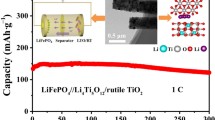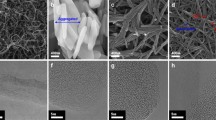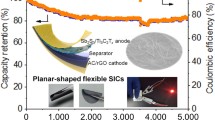Abstract
TiNb2O7 anode materials (TNO) have unique potential for applications in Li-ion capacitors (LICs) due to their high specific capacity of ca. 280 mA h g−1 over a wide anodic Li-insertion potential window. However, their high-rate capability is limited by their poor electronic and ionic conductivity. In particular, studies on TNO for LICs are lacking and that for flexible LICs have not yet been reported. Herein, a unique TNO porous electrode with cross-linked nanorods tailored by post-annealing and its application in flexible LICs are reported. This binder-free TNO anode exhibits superior rate performance (~66.3% capacity retention as the rate increases from 1 to 40 C), which is ascribed to the greatly shortened ion-diffusion length in TNO nanorods, facile electrolyte penetration and fast electron transport along the continuous single-crystalline nanorod network. Furthermore, the TNO anode shows an excellent cycling stability up to 2000 cycles and good flexibility (no capacity loss after continuous bending for 500 times). Model flexible LIC assembled with the TNO anode and activated carbon cathode exhibits increased gravimetric and volumetric energy/power densities (~100.6 W h kg−1/4108.8 W kg−1; 10.7 mW h cm−3/ 419.3 mW cm−3), more superior to previously reported hybrid supercapacitors. The device also efficiently powers an LED light upon 180° bending.
摘要
TiNb2O7的理论比容量高达280 mA h g−1是一类有前景的锂离子电容器负极材料. 然而其较差的电子导电性严重限制了其倍率性能的提升. 在本文中, 我们在柔性碳布表面直接生长3D交联的TiNb2O7纳米棒多孔负极, 并将其首次应用于柔性锂离子电容器;碳布的高导电性, 单晶纳米棒结构较短的离子/电子传输路径以及良好的结构稳定性, 有效提高了材料的倍率性能和循环稳定性. 研究表明, TiNb2O7负极表现出优异的倍率性能(从1到40 C, 容量保持率高达66.3%), 出色的循环稳定性(>2000圈), 以及良好的柔韧性(连续弯曲500次后容量无损失). 此外, 将无粘结剂的TiNb2O7负极和商用活性炭正极搭配成锂离子电容器, 展现出了较高的质量和体积能量/功率密度(~100.6 W h kg−1/4108.8 W kg−1; 10.7 mW h cm−3/419.3 mW cm−3),优于先前报道的混合超级电容器, 同时该器件可以在180°弯曲状态下为LED灯供电.
Similar content being viewed by others
References
Amatucci GG, Badway F, Du Pasquier A, et al. An asymmetric hybrid nonaqueous energy storage cell. J Electrochem Soc, 2001, 148: A930
Jiang Y, Liu J. Definitions of pseudocapacitive materials: a brief review. Energy Environ Mater, 2019, 2: 30–37
Jabeen N, Hussain A, Xia Q, et al. High-performance 2.6 V aqueous asymmetric supercapacitors based on in situ formed Na0.5MnO2 nanosheet assembled nanowall arrays. Adv Mater, 2017, 29: 1700804
Naoi K, Ishimoto S, Miyamoto J, et al. Second generation ‘nano-hybrid supercapacitor’: evolution of capacitive energy storage devices. Energy Environ Sci, 2012, 5: 9363–9373
Simon P, Gogotsi Y, Dunn B. Where do batteries end and super-capacitors begin? Science, 2014, 343: 1210–1211
Wang H, Zhu C, Chao D, et al. Nonaqueous hybrid lithium-ion and sodium-ion capacitors. Adv Mater, 2017, 29: 1702093
Zhang Y, Zhang Z, Tang Y, et al. LiFePO4 particles embedded in fast bifunctional conductor rGO&C@Li3V2(PO4)3 nanosheets as cathodes for high-performance Li-ion hybrid capacitors. Adv Funct Mater, 2019, 29: 1807895
Aricò AS, Bruce P, Scrosati B, et al. Nanostructured materials for advanced energy conversion and storage devices. Nat Mater, 2005, 4: 366–377
Augustyn V, Simon P, Dunn B. Pseudocapacitive oxide materials for high-rate electrochemical energy storage. Energy Environ Sci, 2014, 7: 1597–1614
Aravindan V, Gnanaraj J, Lee YS, et al. Insertion-type electrodes for nonaqueous Li-ion capacitors. Chem Rev, 2014, 114: 11619–11635
Ni J, Fu S, Wu C, et al. Superior sodium storage in Na2Ti3O7 nanotube arrays through surface engineering. Adv Energy Mater, 2016, 6: 1502568
Gao X, Liu X, Wu D, et al. Significant role of Al in ternary layered double hydroxides for enhancing electrochemical performance of flexible asymmetric supercapacitor. Adv Funct Mater, 2019, 29: 1903879
Ohzuku T. Zero-strain insertion material of Li[Li1/3Ti5/3]O4 for rechargeable lithium cells. J Electrochem Soc, 1995, 142: 1431–1435
Naoi K, Ishimoto S, Isobe Y, et al. High-rate nano-crystalline Li4Ti5O12 attached on carbon nano-fibers for hybrid super-capacitors. J Power Sources, 2010, 195: 6250–6254
Zuo W, Wang C, Li Y, et al. Directly grown nanostructured electrodes for high volumetric energy density binder-free hybrid supercapacitors: a case study of CNTs//Li4Ti5O12. Sci Rep, 2015, 5: 7780–7788
Zukalová M, Kalbác M, Kavan L, et al. Pseudocapacitive lithium storage in TiO2 (B). Chem Mater, 2005, 17: 1248–1255
Liu S, Jia H, Han L, et al. Nanosheet-constructed porous TiO2-B for advanced lithium ion batteries. Adv Mater, 2012, 24: 3201–3204
Dylla AG, Henkelman G, Stevenson KJ. Lithium insertion in nanostructured TiO2 (B) architectures. Acc Chem Res, 2013, 46: 1104–1112
Kim HS, Cook JB, Lin H, et al. Oxygen vacancies enhance pseudocapacitive charge storage properties of MoO3−x. Nat Mater, 2017, 16: 454–460
Cook JB, Kim HS, Lin TC, et al. Pseudocapacitive charge storage in thick composite MoS2 nanocrystal-based electrodes. Adv Energy Mater, 2017, 7: 1601283
Li J, Tang Z, Zhang Z. Layered hydrogen titanate nanowires with novel lithium intercalation properties. Chem Mater, 2005, 17: 5848–5855
Wang Y, Hong Z, Wei M, et al. Layered H2Ti6O13-nanowires: A new promising pseudocapacitive material in non-aqueous electrolyte. Adv Funct Mater, 2012, 22: 5185–5193
Cho W, Kashiwagi T, Ra W, et al. Relationship between electrochemical behavior and Li/vacancy arrangement in ramsdellite type Li2+xTi3O7. Electrochim Acta, 2009, 54: 1842–1850
Chernova NA, Roppolo M, Dillon AC, et al. Layered vanadium and molybdenum oxides: batteries and electrochromics. J Mater Chem, 2009, 19: 2526–2552
Li Q, Wei Q, Wang Q, et al. Self-template synthesis of hollow shell-controlled Li3VO4 as a high-performance anode for lithium-ion batteries. J Mater Chem A, 2015, 3: 18839–18842
Kumagai N. Thermodynamics and kinetics of lithium intercalation into Nb2O5 electrodes for a 2 V rechargeable lithium battery. J Electrochem Soc, 1999, 146: 3203–3210
Kim JW, Augustyn V, Dunn B. The effect of crystallinity on the rapid pseudocapacitive response of Nb2O5. Adv Energy Mater, 2012, 2: 141–148
Augustyn V, Come J, Lowe MA, et al. High-rate electrochemical energy storage through Li+ intercalation pseudocapacitance. Nat Mater, 2013, 12: 518–522
Wang H, Zhang Y, Ang H, et al. A high-energy lithium-ion capacitor by integration of a 3D interconnected titanium carbide nanoparticle chain anode with a pyridine-derived porous nitrogen-doped carbon cathode. Adv Funct Mater, 2016, 26: 3082–3093
Sun YG, Sun TQ, Lin XJ, et al. Facile synthesis of hollow Ti2Nb10O29 microspheres for high-rate anode of Li-ion batteries. Sci China Chem, 2018, 61: 670–676
Cai Y, Ku L, Wang L, et al. Engineering oxygen vacancies in hierarchically Li-rich layered oxide porous microspheres for high-rate lithium ion battery cathode. Sci China Mater, 2019, 62: 1374–1384
Chen L, Jiang H, Hu Y, et al. In-situ growth of ultrathin MoS2nanosheets on sponge-like carbon nanospheres for lithium-ion batteries. Sci China Mater, 2018, 61: 1049–1056
Lou L, Kong X, Zhu T, et al. Facile fabrication of interconnected-mesoporous T-Nb2O5 nanofibers as anodes for lithium-ion batteries. Sci China Mater, 2019, 62: 465–473
Wu Y, Cao C. The way to improve the energy density of super-capacitors: Progress and perspective. Sci China Mater, 2018, 61: 1517–1526
Huang ZD, Zhang TT, Lu H, et al. Bimetal-organic-framework derived CoTiO3 mesoporous micro-prisms anode for superior stable power sodium ion batteries. Sci China Mater, 2018, 61: 1057–1066
Hou Y, Chang K, Wang Z, et al. Rapid microwave-assisted refluxing synthesis of hierarchical mulberry-shaped Na3V2(PO4)2O2F @C as high performance cathode for sodium & lithium-ion batteries. Sci China Mater, 2019, 62: 474–486
Han JT, Huang YH, Goodenough JB. New anode framework for rechargeable lithium batteries. Chem Mater, 2011, 23: 2027–2029
Han JT, Goodenough JB. 3-V full cell performance of anode framework TiNb2O7/spinel LiNi0.5Mn1.5O4. Chem Mater, 2011, 23: 3404–3407
Lu X, Jian Z, Fang Z, et al. Atomic-scale investigation on lithium storage mechanism in TiNb2O7. Energy Environ Sci, 2011, 4: 2638–2644
Tang K, Mu X, van Aken PA, et al. “Nano-pearl-string” TiNb2O7 as anodes for rechargeable lithium batteries. Adv Energy Mater, 2013, 3: 49–53
Takami N, Ise K, Harada Y, et al. High-energy, fast-charging, long-life lithium-ion batteries using TiNb2O7 anodes for automotive applications. J Power Sources, 2018, 396: 429–436
Deng Q, Fu Y, Zhu C, et al. Niobium-based oxides toward advanced electrochemical energy storage: recent advances and challenges. Small, 2019, 15: 1804884
Aravindan V, Sundaramurthy J, Jain A, et al. Unveiling TiNb2O7 as an insertion anode for lithium ion capacitors with high energy and power density. ChemSusChem, 2014, 7: 1858–1863
Guo B, Yu X, Sun XG, et al. A long-life lithium-ion battery with a highly porous TiNb2O7 anode for large-scale electrical energy storage. Energy Environ Sci, 2014, 7: 2220–2226
Park H, Wu HB, Song T, et al. Porosity-controlled TiNb2O7 microspheres with partial nitridation as a practical negative electrode for high-power lithium-ion batteries. Adv Energy Mater, 2015, 5: 1401945
Park H, Shin DH, Song T, et al. Synthesis of hierarchical porous TiNb2O7 nanotubes with controllable porosity and their application in high power Li-ion batteries. J Mater Chem A, 2017, 5: 6958–6965
Jo C, Kim Y, Hwang J, et al. Block copolymer directed ordered mesostructured TiNb2O7 multimetallic oxide constructed of nanocrystals as high power Li-ion battery anodes. Chem Mater, 2014, 26: 3508–3514
Lou S, Cheng X, Zhao Y, et al. Superior performance of ordered macroporous TiNb2O7 anodes for lithium ion batteries: Understanding from the structural and pseudocapacitive insights on achieving high rate capability. Nano Energy, 2017, 34: 15–25
Liu G, Zhao L, Sun R, et al. Mesoporous TiNb2O7 microspheres as high performance anode materials for lithium-ion batteries with high-rate capability and long cycle-life. Electrochim Acta, 2018, 259: 20–27
Li H, Shen L, Wang J, et al. Three-dimensionally ordered porous TiNb2O7 nanotubes: a superior anode material for next generation hybrid supercapacitors. J Mater Chem A, 2015, 3: 16785–16790
Wang X, Shen G. Intercalation pseudo-capacitive TiNb2O7@ carbon electrode for high-performance lithium ion hybrid electrochemical supercapacitors with ultrahigh energy density. Nano Energy, 2015, 15: 104–115
Noh H, Choi W. Preparation of a TiNb2O7 microsphere using formic acid and wrapping with reduced graphene oxide for anodes in lithium ion batteries. J Electrochem Soc, 2016, 163: A1042–A1049
Jiao X, Hao Q, Xia X, et al. Boosting long-cycle-life energy storage with holey graphene supported TiNb2O7network nanostructure for lithium ion hybrid supercapacitors. J Power Sources, 2018, 403: 66–75
Li S, Cao X, Schmidt CN, et al. TiNb2O7/graphene composites as high-rate anode materials for lithium/sodium ion batteries. J Mater Chem A, 2016, 4: 4242–4251
Zhu G, Li Q, Zhao Y, et al. Nanoporous TiNb2O7/C composite microspheres with three-dimensional conductive network for long-cycle-life and high-rate-capability anode materials for lithium-ion batteries. ACS Appl Mater Interfaces, 2017, 9: 41258–41264
Lin C, Hu L, Cheng C, et al. Nano-TiNb2O7/carbon nanotubes composite anode for enhanced lithium-ion storage. Electrochim Acta, 2018, 260: 65–72
Jiang J, Li Y, Liu J, et al. Recent advances in metal oxide-based electrode architecture design for electrochemical energy storage. Adv Mater, 2012, 24: 5166–5180
Gwon H, Hong J, Kim H, et al. Recent progress on flexible lithium rechargeable batteries. Energy Environ Sci, 2014, 7: 538–551
Wang X, Lu X, Liu B, et al. Flexible energy-storage devices: design consideration and recent progress. Adv Mater, 2014, 26: 4763–4782
Hao C, Yang B, Wen F, et al. Flexible all-solid-state super-capacitors based on liquid-exfoliated black-phosphorus nanoflakes. Adv Mater, 2016, 28: 3194–3201
Yang C, Ji X, Fan X, et al. Flexible aqueous Li-ion battery with high energy and power densities. Adv Mater, 2017, 29: 1701972
Deng B, Lei T, Zhu W, et al. In-plane assembled orthorhombic Nb2O5 nanorod films with high-rate Li+ intercalation for high-performance flexible li-ion capacitors. Adv Funct Mater, 2018, 28: 1704330
Gui Q, Ba D, Zhao Z, et al. Synergistic coupling of ether electrolyte and 3D electrode enables titanates with extraordinary coulombic efficiency and rate performance for sodium-ion capacitors. Small Methods, 2018, 3: 1800371
Zuo W, Li R, Zhou C, et al. Battery-supercapacitor hybrid devices: recent progress and future prospects. Adv Sci, 2017, 4: 1600539
Bard A J, Faukner LR. Electrochemical methods: Fundamentals and Applications. New York: Jony Wiley & Sons, Inc., 2001
Funabiki A. Impedance study on the electrochemical lithium intercalation into natural graphite powder. J Electrochem Soc, 1998, 145: 172–178
Aurbach D. Common electroanalytical behavior of Li intercalation processes into graphite and transition metal oxides. J Electrochem Soc, 1998, 145: 3024–3034
Levi MD, Aurbach D. Simultaneous measurements and modeling of the electrochemical impedance and the cyclic voltammetric characteristics of graphite electrodes doped with lithium. J Phys Chem B, 1997, 101: 4630–4640
Macdonald JR. Impedance Spectroscopy: Emphasizing Solid Materials and Systems. New York: Jony Wiley & Sons, Inc., 1987
Chen Z, Augustyn V, Wen J, et al. High-performance super-capacitors based on intertwined CNT/V2O5 nanowire nano-composites. Adv Mater, 2011, 23: 791–795
Wang X, Li G, Chen Z, et al. High-performance supercapacitors based on nanocomposites of Nb2O5 nanocrystals and carbon na-notubes. Adv Energy Mater, 2011, 1: 1089–1093
Lim E, Jo C, Kim H, et al. Facile synthesis of Nb2O5@carbon core- shell nanocrystals with controlled crystalline structure for high-power anodes in hybrid supercapacitors. ACS Nano, 2015, 9: 7497–7505
Song MY, Kim NR, Yoon HJ, et al. Long-lasting Nb2O5-based nanocomposite materials for Li-ion storage. ACS Appl Mater Interfaces, 2017, 9: 2267–2274
Wang Q, Wen Z, Li J. A hybrid supercapacitor fabricated with a carbon nanotube cathode and a TiO2-B nanowire anode. Adv Funct Mater, 2006, 16: 2141–2146
Jung HG, Venugopal N, Scrosati B, et al. A high energy and power density hybrid supercapacitor based on an advanced carbon-coated Li4Ti5O12 electrode. J Power Sources, 2013, 221: 266–271
Yu D, Goh K, Wang H, et al. Scalable synthesis of hierarchically structured carbon nanotube-graphene fibres for capacitive energy storage. Nat Nanotech, 2014, 9: 555–562
Lu X, Yu M, Zhai T, et al. High energy density asymmetric quasisolid-state supercapacitor based on porous vanadium nitride nanowire anode. Nano Lett, 2013, 13: 2628–2633
Xu J, Wang Q, Wang X, et al. Flexible asymmetric supercapacitors based upon Co9S8 nanorod//Co3O4@RuO2 nanosheet arrays on carbon cloth. ACS Nano, 2013, 7: 5453–5462
Kaempgen M, Chan CK, Ma J, et al. Printable thin film super-capacitors using single-walled carbon nanotubes. Nano Lett, 2009, 9: 1872–1876
El-Kady MF, Strong V, Dubin S, et al. Laser scribing of high-performance and flexible graphene-based electrochemical capacitors. Science, 2012, 335: 1326–1330
Acknowledgements
This work was supported by the National Natural Science Foundation of China (51672205, 21673169 and 51972257), the National Key R&D Program of China (2016YFA0202602), and the Natural Science Foundation of Hubei Province (2018CFB581).
Author information
Authors and Affiliations
Contributions
Author contributions Dong H and Lei T performed the experiments; Deng B wrote the paper with support from Liu J, Xiao L and Yue N. All authors contributed to the general discussion.
Corresponding author
Additional information
Conflict of interest
The authors declare that they have no conflict of interest.
Supplementary information Supporting data are available in the online version of the paper.
Jinping Liu received his PhD degree from Central China Normal University (CCNU) in June 2009. During 2008–2011, he did visiting and post-doctoral research at Nanyang Technological University (NTU) in Singapore. He is currently Chair Professor at Wuhan University of Technology. The research interests in Dr. Liu’s group include the synthesis of nanostructures and their electrochemical applications (batteries, super-capacitors and electrocatalysis).
Electronic supplementary material
40843_2019_1225_MOESM1_ESM.pdf
Post-annealing tailored 3D cross-linked TiNb2O7 nanorod electrode: towards superior lithium storage for flexible lithium-ion capacitors
Rights and permissions
About this article
Cite this article
Deng, B., Dong, H., Lei, T. et al. Post-annealing tailored 3D cross-linked TiNb2O7 nanorod electrode: towards superior lithium storage for flexible lithium-ion capacitors. Sci. China Mater. 63, 492–504 (2020). https://doi.org/10.1007/s40843-019-1225-1
Received:
Accepted:
Published:
Issue Date:
DOI: https://doi.org/10.1007/s40843-019-1225-1




